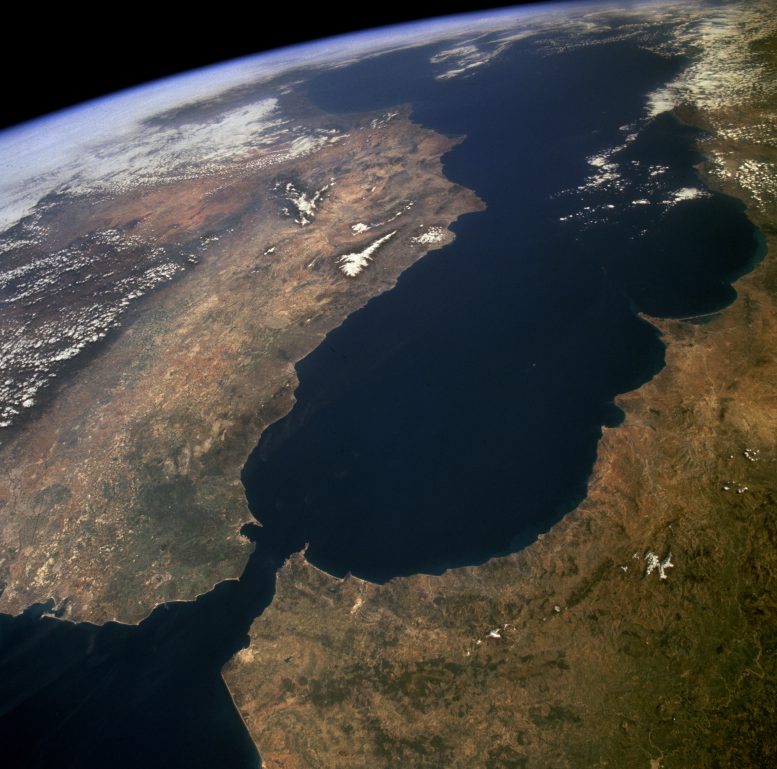
The Gibraltar subduction zone’s slow activity, revealed by new research, indicates it may soon accelerate and contribute to the closing of the Atlantic Ocean, marking a significant phase in the Earth’s geological evolution. This finding underscores the importance of subduction invasion in shaping our planet and highlights the potential for significant seismic activity in the area. Credit: NASA
The Earth’s lithosphere is divided into multiple tectonic plates, which are continuously moving. This movement leads to the formation and fragmentation of supercontinents, alongside the creation, expansion, and eventual shrinking of oceans, a process referred to as the Wilson cycle.
=
In the Wilson cycle, when a supercontinent like Pangea is broken up, an interior ocean is formed. In the case of Pangea, the interior ocean is the Atlantic. This ocean has a rift in the middle, and passive margins on the side, which means no seismic or volcanic activity occurs along its shores. Destined to keep expanding, an Atlantic-type ocean will eventually become the exterior ocean of the next supercontinent. Currently, Earth’s exterior ocean is the Pacific. The Pacific also has a rift in the middle, but it is bounded by subduction zones and thus will eventually close. Along its margins, earthquakes and eruptions abound—a pattern known as the ring of fire.
Subduction and Ocean Closure
The ocean-closing phase of each Wilson cycle requires the transition from passive to active (subducting) margins at the edges of the interior ocean. The oceanic crust along the coast of the Atlantic is old and heavy, so it is primed to subduct, but before it can do so, it must break and bend. The only force in nature that can break oceanic plates like these is slab pull from another subduction zone.
But this doesn’t happen spontaneously. So how does subduction initiate around interior oceans?
Maps showing the evolution of the Gibraltar subduction zone from 30 million years ago to 50 million years into the future. From Duarte et al., 2024. Credit: João C. Duarte
There currently are two subduction zones in the Atlantic: the Lesser Antilles and Scotia. But neither of them formed spontaneously in the Atlantic; they were forced by subduction zones in the Pacific during the Cretaceous and then propagated along transform margins, where the continent is narrow and there is barely a land bridge. They jumped oceans.
Observing Subduction at Gibraltar
Today, on the eastern shore of the Atlantic, in Gibraltar, we have the opportunity to observe the very earliest stages of this process, known as subduction invasion, while the jump occurs from a different basin—in this case, the Mediterranean.
This is an incredibly valuable opportunity because the chances of observing the very start of any given tectonic process are limited. And subduction initiation is difficult to observe because it leaves almost no traces behind. Once subduction starts, it erases the record of its initial stages; the subducted plate ends up in the mantle, never to be exposed at the surface again (except in the rare case of ophiolites).
The activity of the Gibraltar subduction zone in the Mediterranean has been hotly debated. The Gibraltar arc formed in the Oligocene as a part of the Western Mediterranean subduction zones. While we can see a subducted plate in the mantle underneath it, almost no further movement is currently happening.
Map highlighting the Atlantic subduction zones, the fully developed Lesser Antilles and Scotia arcs on the western side and the incipient Gibraltar arc on the eastern side. From Duarte et al., 2018. Credit: João C. Duarte
A new paper by Duarte et al., just published in Geology, suggests that Gibraltar is active—it is just currently experiencing a slow movement phase because the subducting slab is very narrow, and it is trying to pull down the entire Atlantic plate.
“[These are] some of the oldest pieces of crust on Earth, super strong and rigid—if it were any younger, the subducting plate would just break off and subduction would come to a halt,” explains Duarte. “Still, it is just barely strong enough to make it, and thus moves very slowly.”
The Future of Subduction and Its Implications
A new computational, gravity-driven 3-D model, developed by the authors, shows that this slow phase will last for another 20 million years. After that, the Gibraltar subduction zone will invade the Atlantic Ocean and accelerate. That will be the beginning of the recycling of crust on the eastern side of the Atlantic, and might be the start of the Atlantic itself beginning to close, initiating a new phase in the Wilson cycle.
Broadly, this study shows that subduction invasion, the process whereby a new subduction zone forms in an exterior ocean and then migrates to an interior ocean, is likely a common mechanism of subduction initiation in Atlantic-type oceans, and thus plays a key role in the geological evolution of our planet.
Locally, the finding that the Gibraltar subduction is still currently active has important implications for seismic activity in the area. Recurrence intervals are expected to be very long during this slow phase, but the potential for high-magnitude events, such as the 1755 Lisbon earthquake, remains and requires preparedness.
Much remains to be figured out about the future of the Gibraltar arc. One of the next aspects that Duarte will focus on is determining the exact geometry of the subduction, which will require assessing the relative strength of the nearby continental margins.
Reference: “Gibraltar subduction zone is invading the Atlantic ” by João C. Duarte, Nicolas Riel, Filipe M. Rosas, Anton Popov, Christian Schuler and Boris J.P. Kaus, 13 February 2024, Geology.
DOI: 10.1130/G51654.1
>>> Read full article>>>
Copyright for syndicated content belongs to the linked Source : SciTechDaily – https://scitechdaily.com/a-tectonic-twist-how-gibraltar-could-close-the-atlantic-ocean/